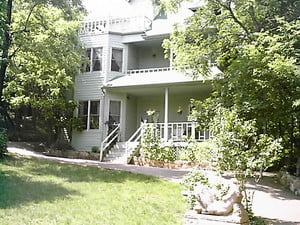Generations of children have adored whimsical, adorable Kewpies, the dolls based on the characters created by artist and author Rose O’Neill. Kewpies are Ozark natives because the artist first conceived of them in a dream at her home, Bonniebrook located near Walnut Shade, Missouri. Today, a rebuilt fourteen room mansion and the Maggie Fisher Visitors Center allow visitors to learn about the remarkable woman who created both the Kewpie and a legend.
First recognized as an artist age the age of 14, O’Neill became the highest paid female illustrator in the United States while still in her teens. A native of Wilkes-Barre, Pennsylvania, the young artist moved to New York City to pursue a career in art. About the same time, her parents, William Patrick and Alice O’Neill, moved to the Ozark wilderness to homestead. The family moved into an existing dog trot cabin on eighty acres and doubled the property by adding another eighty acre section. When daughter Rose came to visit from New York, she was delighted with the beautiful scenery and wild forest in what she dubbed “the tangles.”
After Rose O’Neill became a staff illustrator for Puck Magazine she sent her earnings home to her large family. Soon, a fourteen room mansion was built with the help of local craftsmen and friends. The house rose three stories tall on the home place Rose had already named “Bonniebrook”.
Rose O’Neill drew many ads for products that included Jell-O and illustrated many popular stories of the day. She also became an author with several published novels. As her career soared, Rose married first Gray Latham who spent her money before it came into her hands. She filed for a divorce at the Taney County, Missouri courthouse in 1901 and remained at Bonniebrook. Another marriage to Henry Leon Wilson failed in 1907 and she again came home to concentrate on her art.
During an afternoon nap in the front bedroom she called her “treetop studio”, Rose dreamed of cupid-like figures who cavorted across the covers. When she woke, the figures lingered and she began sketching what would become her famous Kewpies.
Kewpies first appeared in the pages of The Ladies Home Journal in 1909 and were immediately popular. Issues with stories about Kewpies sold out on the newsstand and demand led to the creation of the first Kewpie dolls in 1912. Within a year, O’Neill was a millionaire and she again left her beloved Bonniebrook for the outside world.
Over the next few years, Rose O’Neill lived large. She maintained an apartment in New York’s Greenwich Village, a castle in Connecticut, and an Italian villa on the Isle of Capri. Her fame allowed her to visit Europe’s royalty and she was named as one of the world’s five most beautiful women. Nicknamed “The Queen of Bohemian Society”, she spoke out on women’s issues and pushed for the right to vote. Her multiple homes were filled with precious antiques and artwork. Rose’s generosity overflowed to her family and her many friends.
During the Roaring Twenties, Rose O’Neill remained a light of famous society. Her open salons drew the famed poets, actors, writers, dancers, and thinkers of the period. A popular song, Rose of Washington Square, was written in Rose’s honor. Exhibitions of her Kewpie art, her “sweet monsters” were held in both New York and Paris.
Kewpies and Kewpie dolls were very popular. Dolls were made in all price ranges because Rose wanted every child who longed for one to have a Kewpie to cuddle. Kewpies were collected by adults as well and Kewpie stories remained a favorite. By the mid-1930’s however, Kewpies began to fall from vogue. Some believe that Disney’s new cartoon characters drew fans away from O’Neill’s Kewpies. Animated movies developed new characters and these became popular.
At the same time, Rose’s money had begun to ebb away and she returned home to Bonniebrook to remain. Her mother, whom she called Meemie, had died and Rose made her Ozark retreat her permanent residence. By 1940 most of her fortune was gone along with many of her friends. That same year Rose spent most of her dwindling funds to add electricity to Bonniebrook as well as steam heat. She also installed a telephone, one of the first in the area and after realizing that she had no one to call, Rose installed telephones for several of her neighbors.
During World War II, shiploads of Kewpies made in Germany factories were sunk by British warships and her financial situation worsened.
Rose O’Neill spent her last years in the Ozarks. Ever active, she donated time and artwork to the School of the Ozarks (now College of the Ozarks) at Point Lookout. She spoke at artist’s workshops and at women’s rallies. She continued to write, to draw, and to sculpt for the remainder of her life. Of her many creations, the Kewpies held a special place in her heart.
She died at her nephew’s home in nearby Springfield, Missouri in April, 1944 and she was buried in a quiet Ozark glade near her home.
Three years later, the original Bonniebrook burned to the ground. Her youngest brother, Clarence O’Neill was the occupant and he left a space heater burning for a sick kitten. While visiting neighbors, the home caught on fire and was soon engulfed. Rose’s beloved Bonniebrook burned to the ground.
In the decades after her death, Kewpie dolls remained popular although the dolls would never again rank as the most popular toy on the market. Rose O’Neill’s reputation grew and in 1984, a group called “The Friends of Rose O’Neill” began rebuilding Bonniebrook. The replica was built just as the original had been, in stages and with volunteer labor. Built using the plans of the first house, the new Bonniebrook stands today as it did in Rose’s lifetime.
The Maggie Fisher Visitor’s Center offers an extensive museum with Rose’s original artwork on display. Letters, copies of her novels, photographs, and many personal items can be seen. Guided tours of the rebuilt home are offered and a Kewpie Gift Shop is also on site.
Bonniebrook is located at 485 Rose O’Neill Road near Walnut Shade, Missouri deep in the Ozark hills. It is listed on the National Register of Historical Places and can be accessed from US 65 between Springfield and Branson.
Visitors can tour the site between April 1 and November 30, Monday through Saturday, 9am until 4m.
Admission is minimal, $7 for adults and children under twelve are admitted free.
Bonniebrook remains nestled in a quiet clearing surrounding by Ozark forests as it was in Rose’s lifetime. A trail leads into the woods where Rose’s grave can be found near a clear spring in a shaded clearing. Other family members are also buried in the private cemetery.
Kewpie doll collectors, the curious, and Kewpie fans make their way to Bonniebrook each year in large numbers to pay homage to Rose O’Neill and to the Kewpies, perhaps the region’s most famous natives.


